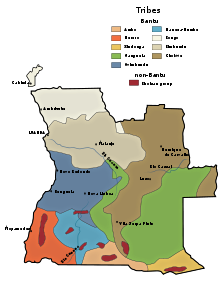
Angola, officially the Republic of Angola, is a country on the west-central coast of Southern Africa. It is the second-largest Lusophone (Portuguese-speaking) country in both total area and population and is the seventh-largest country in Africa. It is bordered by Namibia to the south, the Democratic Republic of the Congo to the north, Zambia to the east, and the Atlantic Ocean to the west. Angola has an exclave province, the province of Cabinda, that borders the Republic of the Congo and the Democratic Republic of the Congo. The capital and most populous city is Luanda.
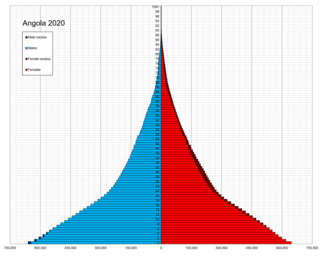
Demographic features of the population of Angola include population density, ethnicity, education level, health of the populace, economic status, religious affiliations and other aspects.
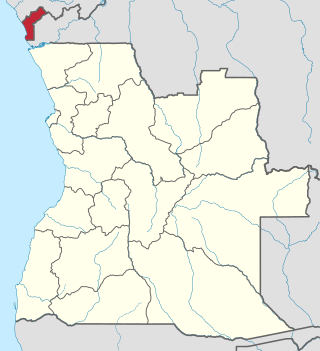
Cabinda is an exclave and province of Angola, a status that has been disputed by several political organizations in the territory. The capital city is also called Cabinda, known locally as Tchiowa, Tsiowa or Kiowa. The province is divided into four municipalities—Belize, Buco-Zau, Cabinda and Cacongo.
The Kavango people, also known as the vaKavango or haKavango, are a Bantu ethnic group that resides on the Namibian side of the Namibian–Angolan border along the Kavango River. They are mainly riverine living people, but about 20% reside in the dry inland. Their livelihood is based on fishery, livestock-keeping and cropping. The Kavango Region of Namibia is named after the people.
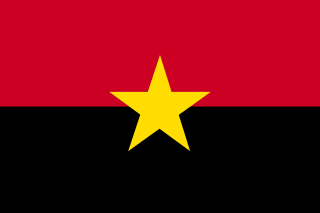
The People's Movement for the Liberation of Angola, for some years called the People's Movement for the Liberation of Angola – Labour Party, is an Angolan social democratic political party. The MPLA fought against the Portuguese Army in the Angolan War of Independence from 1961 to 1974, and defeated the National Union for the Total Independence of Angola (UNITA) and the National Liberation Front of Angola (FNLA) in the Angolan Civil War. The party has ruled Angola since the country's independence from Portugal in 1975, being the de facto government throughout the civil war and continuing to rule afterwards.

The culture of Angola is influenced by the Portuguese. Portugal occupied the coastal enclave Luanda, and later also Benguela, since the 16th/17th centuries, and expanded into the territory of what is now Angola in the 19th/20th centuries, ruling it until 1975. Both countries share prevailing cultural aspects: the Portuguese language and Roman Catholicism. However, present-day Angolan culture is mostly native Bantu, which was mixed with Portuguese culture. The diverse ethnic communities with their own cultural traits, traditions and native languages or dialects include the Ovimbundu, Ambundu, Bakongo, Chokwe, Avambo and other peoples.

The Caprivi Strip, also known simply as Caprivi, is a geographic salient protruding from the northeastern corner of Namibia. It is bordered by Botswana to the south and Angola and Zambia to the north. Namibia, Botswana and Zambia meet at a single point at the eastern tip of the Strip, which also comes within 150 m (490 ft) of Zimbabwe thus nearly forming a quadripoint. Botswana and Zambia share a 150-metre (490 ft) border at the crossing of Kazungula. The territory was acquired by then-German South West Africa in order to provide access to the Zambezi River and consequently a route to the east coast of the continent and German East Africa. The route was later found not to be navigable because of the location of the Victoria Falls, one of the world's largest waterfalls, about 65 kilometres east of the Caprivi Strip.
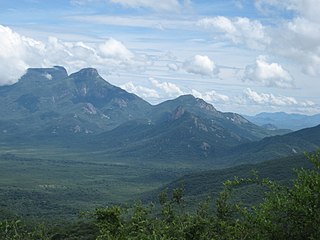
Huíla is a province of Angola. It has an area of 79,023 square kilometres (30,511 sq mi) and a population of 2,497,422. Lubango is the capital of the province. Basket-making is a significant industry in the province; many make baskets out of reeds.

The Ovimbundu, also known as the Southern Mbundu, are a Bantu ethnic group who live on the Bié Plateau of central Angola and in the coastal strip west of these highlands. As the largest ethnic group in Angola, they make up 38 percent of the country's population. Overwhelmingly the Ovimbundu follow Christianity, mainly the Igreja Evangélica Congregacional de Angola (IECA), founded by American missionaries, and the Catholic Church. However, some still retain beliefs and practices from African traditional religions.

Ambriz is a village and municipality in Bengo Province, Angola. It is located 127 km from the town of Caxito. It borders the municipality of N'zeto, Zaire Province, to the north and the municipality of Dande to the south.

Portuguese is the only official language of Angola, but 46 other languages are spoken in the country, mostly Bantu languages.
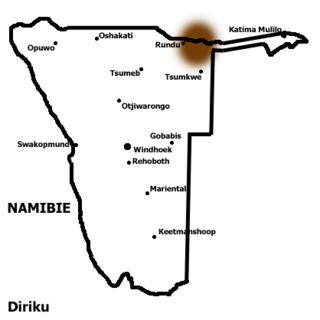
Gciriku, or Dciriku, is a Bantu language spoken by 305,000 people along the Kavango River in Namibia, Botswana and Angola. 24,000 people speak Gciriku in Angola, according to Ethnologue. It was first known in the west via the Vagciriku, who had migrated from the main Vamanyo area and spoke Rugciriku, a dialect of Rumanyo. The name Gciriku remains common in the literature, but within Namibia the name Rumanyo has been revived. The Mbogedu dialect is extinct; Maho (2009) lists it as a distinct language, and notes that the names 'Manyo' and 'Rumanyo' are inappropriate for it.
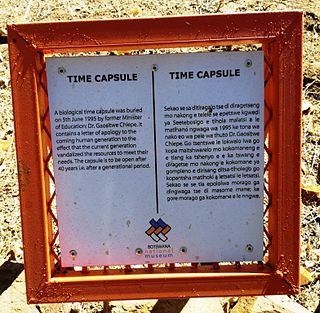
The official language of Botswana is English, while Setswana is considered to be a national language. English, which was inherited from colonial rule, is the language of official business and most written communication. Most of the population speak Setswana, but over 20 smaller languages are also spoken. Some of the country's languages are in danger of becoming extinct.

Namibia, despite its scant population, is home to a wide diversity of languages, from multiple language families: Germanic, Bantu, and the various Khoisan families. When Namibia was administered by South Africa, Afrikaans, German, and English enjoyed an equal status as official languages. Upon Namibian independence in 1990, English was enshrined as the nation's sole official language in the constitution of Namibia. German and Afrikaans were stigmatised as relics of the colonial past, while the rising of Mandela's Youth League and the 1951 Defiance Campaign spread English among the masses as the language of the campaign against apartheid.

The population of Botswana is divided into the main ethnic groups of Tswana people (73%), Kalanga people (18%), and Basarwa (2%). The remaining 7% consist of other peoples, including some speaking the Kgalagadi language, and 1% of non-African people.

Portuguese Angola refers to Angola during the historic period when it was a territory under Portuguese rule in southwestern Africa. In the same context, it was known until 1951 as Portuguese West Africa.
Mbukushu is a traditional Kavango kingdom on the territory of today's Namibia, Botswana, Zambia and Angola. Its people speak the Mbukushu language. As of 2016, the Mbukushu are said to comprise 20,000 to 44,000 people. There are said to be around 20,000 Mbukushu people in Botswana, around 6,900 in Namibia (2002), 5,000 in Zambia and 4,000 in Angola.

Bagani is a settlement on the south-western banks of the Okavango River in the Kavango East Region of Namibia, 200 kilometres (120 mi) east of Rundu and near the Popa Falls on the Okavango River. Bagani has a population of around 2.000 inhabitants and is homestead of the local Mbukushu kings.
Mbunda is a Bantu language of Angola and Zambia. There are several dialects: Katavola, Yauma, Nkangala, Mbalango, Sango, Ciyengele ("Shamuka"), and Ndundu, all of which are closely related. Mbunda was one of six languages selected by the Instituto de Línguas Nacionais for an initial phase to establish spelling rules in 1980 to facilitate teaching in schools and promoting its use.
The voiceless nasal glottal approximant is a type of consonantal sound, a nasal approximant, used in some oral languages. The symbol in the International Phonetic Alphabet that represents this sound is ⟨h̃⟩, that is, an h with a tilde.
